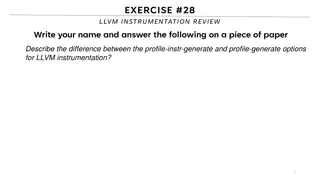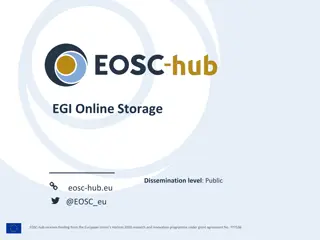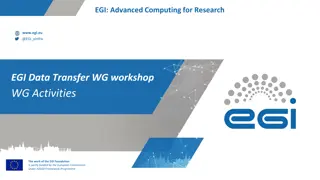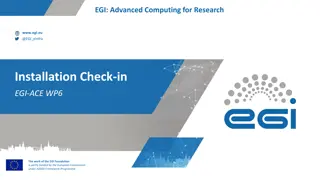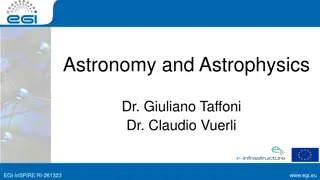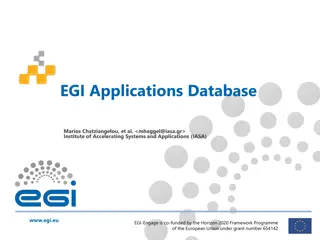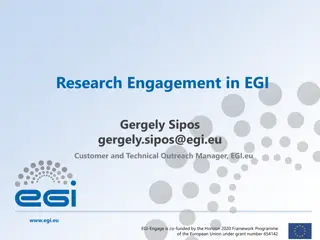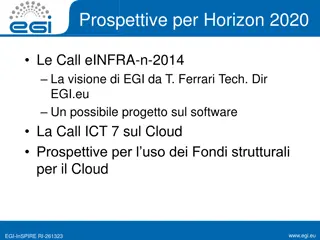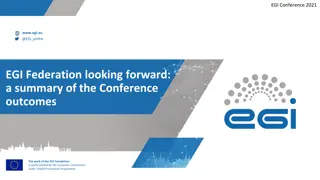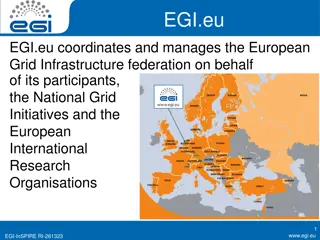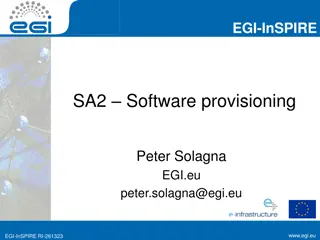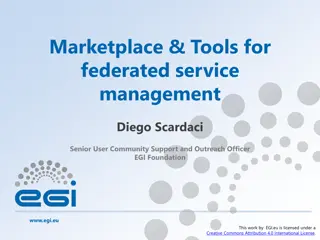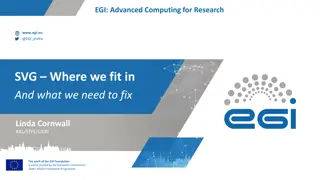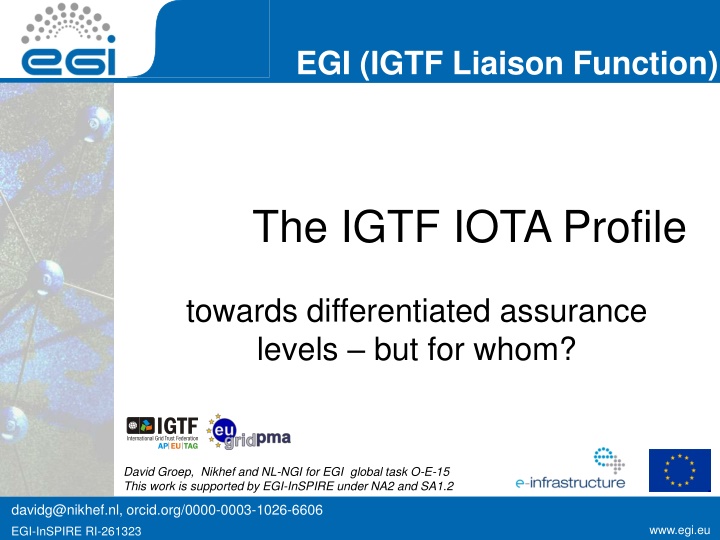
Differentiated Assurance Levels in EGI: A Deep Dive into Identity Assurance
Explore the intricate layers of assurance levels within EGI, focusing on identity assurance and risk redistribution. Learn about the collaborative approach to differentiating assurance levels for diverse infrastructures and services, ultimately aiming to enhance security while simplifying user experiences.
Download Presentation

Please find below an Image/Link to download the presentation.
The content on the website is provided AS IS for your information and personal use only. It may not be sold, licensed, or shared on other websites without obtaining consent from the author. If you encounter any issues during the download, it is possible that the publisher has removed the file from their server.
You are allowed to download the files provided on this website for personal or commercial use, subject to the condition that they are used lawfully. All files are the property of their respective owners.
The content on the website is provided AS IS for your information and personal use only. It may not be sold, licensed, or shared on other websites without obtaining consent from the author.
E N D
Presentation Transcript
EGI (IGTF Liaison Function) The IGTF IOTA Profile towards differentiated assurance levels but for whom? David Groep, Nikhef and NL-NGI for EGI global task O-E-15 This work is supported by EGI-InSPIRE under NA2 and SA1.2 davidg@nikhef.nl, orcid.org/0000-0003-1026-6606 www.egi.eu www.egi.eu EGI-InSPIRE RI-261323 EGI-InSPIRE RI-261323
Broad outline diverse infrastructures: the use cases for IOTA Differentiated and Collaborative Assurance Risk Profile IGTF Federation Charter and structure assurance levels NIST/Kantara vs. Classic, MICS, SLCS .. and IOTA differentiated collaborative assurance IOTA Profile: a really different level! What You See Is What You Get (and no more) caveats for IOTA questions RPs should be asking themselves EUGridPMA for EGI-TF13 www.egi.eu EGI-InSPIRE RI-261323
Times are achangeging More diverse services portal services, data-only, IaaS clouds more closely integrated: directly exposed to users Can we simplify the user experience and reduce duplicate efforts and still stay reasonably secure? We have (well-)managed AAI federations in many countries are now well established infrastructures with defined (and at times adhered-to) procedures but that are quite differently structured EUGridPMA for EGI-TF13 www.egi.eu EGI-InSPIRE RI-261323
Differentiated assurance EGI: VO Portal Policy 4 levels of impact -> 4 levels of identity assurance Inspired by portals (science gateways), but not limited thereto EGI SPG: https://documents.egi.eu/document/80 Actions vs assurance level Click-only portals anonymous, but rate limited Parameter portals email reg, rate limited Data storage LoA-1 , unqualified federated, site-specific agreements for write access Arbitrary executables traceable and persistent ID EUGridPMA for EGI-TF13 www.egi.eu EGI-InSPIRE RI-261323
Redistributing risk risk envelope Subject (ID/LoA) based Defined identity assurance level Includes Community-given LoA For given actions, resources, and acceptable residual risk, required ID assurance is a given Action (app) based More constraint actions can lower need for identity LoA (J)SPG VO Portal policy did just that: 4 levels of actions Resource (value) based e.g. access to wireless network does not pose huge risks, so can live with a lower identity LoA (eduroam) Towards differentiated collaborative LoA 2013-04-11 www.egi.eu EGI-InSPIRE RI-261323
Trust Element Distribution (Classic, MICS, SLCS) Technical elements Identity elements integrity of the roots of trust integrity of issuance process process incident response revocation capabilities identifier management re-binding and revocation binding to entities traceability of entities emergency communications IGTF Classic elements key management credential management incident response RP, Community elements regular communications rich attribute assertions correlating identifiers access control Verifiability & Response, mitigation, recovery 2013-04-11 Towards differentiated collaborative LoA www.egi.eu EGI-InSPIRE RI-261323
Parties to assurance level Identity assertions IGTF: Classic, MICS SLCS experimental Community (attribute) assertions Largely unexplored, AAOps Guidelines take a step EGI VO registration policy (relatively weak) PRACE site registration procedures (status is mixed) Resource providers In EGI usually don t vet the user This is more common in other infra s PRACE: per-site additional vetting possible XSEDE: centrally vetted EUGridPMA for EGI-TF13 www.egi.eu EGI-InSPIRE RI-261323
Collaborative assurance Cater for those use cases where the RPs (VOs) already collect identity data this RP (VO) data is authoritative and provides traceability the identity component of the credential is not used through an AP where the authority provides only persistent, non-reused identifiers traceability only at time of issuance naming be real or pseudonymous (discussion on going!) good security for issuance processes and systems and where the RP will have to take care of subscribers changing name often (in case traceability at issuing authority is lost) all named identity vetting, naming and contact details EUGridPMA for EGI-TF13 www.egi.eu EGI-InSPIRE RI-261323
EGI (IGTF Liaison Function) The IGTF a small diversion if needed EUGridPMA for EGI-TF13 www.egi.eu www.egi.eu EGI-InSPIRE RI-261323 EGI-InSPIRE RI-261323
Global Trust 86 accredited authorities from 53 countries and economic regions www.egi.eu EGI-InSPIRE RI-261323
IGTF Structure of Trust Common criteria and model globally unique and persistent identifier provisioning not fully normative, but based on minimum requirements Trust is technology agnostic technology and assurance profiles in the same trust fabric classic traditional public key infrastructure MICS dynamic ID provisioning leveraging federations SLCS on-demand short-lived token generation a basis for arbitrary token services new profiles International Grid Trust Federation 2005 - 2011 2011-06-10 www.egi.eu EGI-InSPIRE RI-261323
IGTF Common Criteria International Grid Trust Federation 2005 - 2011 2011-06-10 www.egi.eu EGI-InSPIRE RI-261323
Assurance levels in the IGTF Technical and operational controls Authorities come in two basic flavours off-line(only used in traditional PKI): human controls and air-gap security provide protection against attacks on-line infrastructure (federation-backed, SLCS and classic): valuable security material is network connected need compensatory controls: secure hardware, compliant to FIPS 140-2 level 3 additional layered network security Technical requirements apply to any attribute source such as community registries like VOMS International Grid Trust Federation 2005 - 2011 2011-06-10 www.egi.eu EGI-InSPIRE RI-261323
Vetting Assurance Levels Identity controls and vetting long-term traceable assurance (classic, MICS) based on in-person checking of (nationally defined) official identity documents recorded identity persists beyond the moment of issuance assertions can live for a long time (over a year) to facilitate long-term use but compromise may happen, so is revocable momentary assurance (SLCS) traceability to a physical person for at least one year may use any vetting mechanism that assures that traceability but assertions are limited in time to 24 hours (unless revocable, in which case: 11 days) https://www.eugridpma.org/guidelines/{classic,mics,slcs} International Grid Trust Federation 2005 - 2011 2011-06-10 www.egi.eu EGI-InSPIRE RI-261323
EGI (IGTF Liaison Function) Collaborative assurance back on track EUGridPMA for EGI-TF13 www.egi.eu www.egi.eu EGI-InSPIRE RI-261323 EGI-InSPIRE RI-261323
Assurance levels Trust in the identity assertions by resource and service providers is key Until now, our e-Infrastructure used a single level there are well-known government standards for LoA (US: OMB M-04-04 & NIST SP800-63) but 95/46/EC and 1999/93/EC are not of much use to us and the Nice treaty states that identity is a national matter there is rough but not 1:1 correspondence between balanced needs of the providers and users and the NIST LoA levels International Grid Trust Federation 2005 - 2011 2011-06-10 www.egi.eu EGI-InSPIRE RI-261323
IGTF Assurance Levels Type and classification of e-Infrastructure services drives the level of assurance required Security and assurance level set to be commensurate not overly high for commodity resources not too low, as providers otherwise start implementing additional controls on top of and over the common criteria defined in collaboration with resource providers using transparency and a peer review processes leveraging our own community organisation mechanisms International Grid Trust Federation 2005 - 2011 2011-06-10 www.egi.eu EGI-InSPIRE RI-261323
Redistributing responsibilities Subject (ID) based Effective LoA is retained For given actions, resources, and acceptable residual risk, required ID assurance is a given can shift line in identity trust level Action (app) based More constraint actions can lower need for identity LoA (J)SPG VO Portal policy did just that: 4 levels of actions Resource (value) based e.g. access to wireless network does not pose huge risks, so can live with a lower identity LoA (eduroam) Towards differentiated collaborative LoA 2013-04-11 www.egi.eu EGI-InSPIRE RI-261323
Who does What? EGI: very heterogeneous (many VO communities, many providers, limited control) VOs and sites to answer you with who did what when where can take ages or will not work User-orig delegation & classic ID vetting (IGTF Classic, MICS, SLCS) give you tracability and ID PRACE T1s: all data is ( should be ) in central LDAP, ought to have no need for using IGTF ID for finding user CERN HR (wLCG): association to existing ID, existing User has all data EUGridPMA for EGI-TF13 www.egi.eu EGI-InSPIRE RI-261323
EGI (IGTF Liaison Function) PRACE vetting based on slides from Vincent back on track EUGridPMA for EGI-TF13 www.egi.eu www.egi.eu EGI-InSPIRE RI-261323 EGI-InSPIRE RI-261323
The PRACE security model Authentication X.509 certificates (EUGridPMA, IGTF) Services using X.509 authentication : GSI-SSH, UNICORE, GridFTP, GRAM, web services SSO (MyProxy server) Authorization LDAP used as an authorization database Fine grained management Attributes associated to projects (groups of persons) Attributes associated to accounts Accounting Distributed database (DART for access) Accounting records compliant to OGF Usage Record format
User registration in PRACE (1/2) user DB user DB site B site A User authz Project attributes LDAP Review DB user DB site C a) PRACE Project Administration b) Federated User Administration c) Authorized Access to Resources
User registration in PRACE (2/2) User registration is done by each partner for users from their country or by assignment. User is only registered once for all sites. Rules are not very explicit for Tier-1 sites. It is assumed that sites have a contract with the user that they register and that they have a clear evidence on how to trace the user.
Information collected by sites and published in LDAP - First name, last name - Email - Telephone number - Certificate subject DN - Nationality - Login details, group memberships, organization ( Home site )
Why do we need this information ? - Site local policies require a clear traceability (no anonymous access on the execution sites). - Some sites need this information to initiate a local authorization procedure which can lead in the worse cases to access refusal.
This profile may be accepted by PRACE if we are convinced that for every internal registered user we have enough information to trace that user. (the next two slides quote parts form the profile which make clear why we need the above requirement) Users from other infrastructures can only be accepted if that infrastructure has the same requirement for traceability of the user and can provide us with this information if asked for (in agreed situations).
EGI (IGTF Liaison Function) IOTA Profile back on track Linking a generic ID to pre-existing user data EUGridPMA for EGI-TF13 www.egi.eu www.egi.eu EGI-InSPIRE RI-261323 EGI-InSPIRE RI-261323
IOTA AP Trust difference Provide only (opaque) identifiers, nothing more Easier to obtain for users, but must be complemented by RP for traceability and integrity who should have that data already 3,4 LoA 2: 1, 2-factor vetting, verified traceability, externally audited as matter of course 2 MICS, Classic: identified naming, traceability, longer-term, limited auditing Vetting LoA scale RP task SLCS: identified naming, point-in-time traceability, time-limited IOTA AP: unique identification, no identity , limited traceability 1 * somewhat my personal view sorry for bias LoA 1: verified email address with mail-back LoA 0: like conventional unsigned email EUGridPMA for EGI-TF13 www.egi.eu EGI-InSPIRE RI-261323
Moving the bar towards differentiated assurance http://wiki.eugridpma.org/Main/IOTASecuredInfraAP IOTA AP assurance level is different, and rest must be taken up by somebody else Consider questions about Real names and pseudonyms Enrolling users in a community Keeping audit records in the VO Auditability and tracing Incident response Identity elements identifier management re-binding and revocation binding to entities traceability of entities emergency communications regular communications rich attribute assertions correlating identifiers access control As a new profile next to classic, MICS, SLCS Towards differentiated collaborative LoA 2013-04-11 www.egi.eu EGI-InSPIRE RI-261323
EGI (IGTF Liaison Function) IOTA Profile http://wiki.eugridpma.org/Main/IOTASecuredInfraAP EUGridPMA for EGI-TF13 www.egi.eu www.egi.eu EGI-InSPIRE RI-261323 EGI-InSPIRE RI-261323
Profile Structure General items (from the federation level) subject names must be globally unique persistent for the life time of the authority Architectural model It s about people and robots, not servers or services Naming of IOTA subjects must be distinct migration of named does not work since it itself was not vetted If every eligible entity name was any vetted, then it can be done Supposedly backed by federation (InCommon, UKAMF, or maybe even all of eduGAIN?) EUGridPMA for EGI-TF13 www.egi.eu EGI-InSPIRE RI-261323
IdM Relationships subscriber identity is maintained by the credential issuing authority or by third parties [read: federation] trusted by the authority for the purposes of identifier assignment. Any such third parties must have a documented and verifiable relationship with the issuing authority, and through this relationship the issuing authority must have documented, verifiable and auditable means to ensure the requirements of this authentication profile are met [this auditing does not implicitly extend to actual IDs, see later] EUGridPMA for EGI-TF13 www.egi.eu EGI-InSPIRE RI-261323
Explicit caveat! Credentials issued by authorities operating under this Authentication Profile should be used primarily in conjunction with vetting and authentication data collected by the relying parties, such that there is less need for collecting data that would otherwise duplicate efforts already performed by such relying parties. Authorities are not required to collect more data than are necessary for fulfilling the uniqueness requirements. Credentials issued by authorities under this profile may not provide sufficient information to independently trace individual subscribers, and should be used in conjunction with complementary identification and vetting processes. EUGridPMA for EGI-TF13 www.egi.eu EGI-InSPIRE RI-261323
Naming opaque unique identifier OR name chosen by the requestor and obtained from (a list proposed by) the IdP on which the issuer will enforce uniqueness. The set of subject name elements included must: identify the identity management system contain sufficient information [ ] allows unique identification of the vetted entity in this identity management system; with a verified element in the credential [not: subject] that allows direct contact to the subject (e.g. an email address(1)), correct at time of issuance; subjectAlternativeName contains emailAddress EUGridPMA for EGI-TF13 www.egi.eu EGI-InSPIRE RI-261323
Records and tracability the authority must retain sufficient information, or have sufficient information retained on its behalf, such that the persistency of name binding can be guaranteed. The authority may rely in good faith [not: audited and verified] on identity management systems by third parties, provided such third parties retain the necessary records. EUGridPMA for EGI-TF13 www.egi.eu EGI-InSPIRE RI-261323
Traceability At credential issuing time [not: for the validity of the credential], the authority must reasonably demonstrate how it can verify identity information and trace this information back to a physical person (or for non-human credentials to a named group). At the time of issuance, the authority may rely in good faith on any identity management system by a third party with which it has entered into an agreement [ ] EUGridPMA for EGI-TF13 www.egi.eu EGI-InSPIRE RI-261323
Revocation Any entity can request revocation if they can sufficiently demonstrate compromise or exposure of the associated private key material, or if they can demonstrate that any data contained in the credential is incorrect. Managers of identity management systems involved in issuing credentials may [not: should or must] request revocation of credentials if their stored identity data changes or when traceability to the person is lost. Individual holders of a credential must request revocation if the private key pertaining to the credential is lost or has been compromised, or if the data in the credential are no longer valid. EUGridPMA for EGI-TF13 www.egi.eu EGI-InSPIRE RI-261323
Security and Incident Response systems of the authority or at third parties with which the authority has entered into an agreement for identity management should [not: must] be highly secure and trustworthy systems, [...] The authority must not knowingly continue to rely on data from third parties that provide inaccurate or fraudulent information. It is strongly recommended that any third party on which the issuing authority relies has an incident response capability and is willing to participate in resolving such incidents. [but notably in InCommon this is not part of the agreement and some org intentionally don t want to] EUGridPMA for EGI-TF13 www.egi.eu EGI-InSPIRE RI-261323
Auditing Each authority must accept being audited by another accredited authority to verify its compliance with the rules and procedures specified in its CP/CPS document. The authority should perform internal operational audits of its staff and of interfaces between components and systems. These audits should be performanced at least once per year to verify its compliance with the rules and procedures specified in its CP/CPS document. Audit results shall be made available to the accrediting body upon request. A list of authority and site identity management personnel should be maintained and verified at least once per year. The auditing does not necessarily extend to identity vetting systems operated by third parties and used for credential issuance. EUGridPMA for EGI-TF13 www.egi.eu EGI-InSPIRE RI-261323
Accreditation process There are lots of should s and recommendation in the list these get evaluated by the accrediting PMA We expect managed federations to be used: national NREN-run federations like those in eduGAIN. Then you effectively get a lot more! InCommon is also managed, but their basic membership level suffers from the don t-ask- any-questions encourage programme there are hardly any requirements in there , lots of orgs don t bother to (tell they) do it right EUGridPMA for EGI-TF13 www.egi.eu EGI-InSPIRE RI-261323
IOTA Identity Providers Who can provide IOTA? CILogon InCommon Basic (not OpenID) UK NES SARoNGS In future maybe a new SP serving eduGAIN IdPs the eduGAIN federation template looks strong enough and better than InCommon w.r.t incident response Who can actually use it? XSEDE is willing to accept at least InCommon Basic UK NGS might accept SARoNGS you get the idea ;-) but this ought to start changing EUGridPMA for EGI-TF13 www.egi.eu EGI-InSPIRE RI-261323
EGI (IGTF Liaison Function) IOTA Technical Deployment Distribution and use considerations EUGridPMA for EGI-TF13 www.egi.eu www.egi.eu EGI-InSPIRE RI-261323 EGI-InSPIRE RI-261323
Technical trust remains loosing technical trust would make any authentication infrastructure useless so integrity of the issuer has to be retained just like for the AA Operations Guidelines similar to the classic, mics and slcs profiles both issuing system and ID management secure retention of records for incident response When contracting back-end (university) IdPs the requirements must apply to them as well www.egi.eu EGI-InSPIRE RI-261323
From IGTF to RP IGTF Distribution is not monolithic Authorities comes in bundles for each profile RPs select one or more profiles as sufficient and may add their own authorities as well e.g: EGI policy on trusted authorities accepts Classic, MICS and SLCS And there is no IGTF all distribution on purpose! With more diverse profiles (and LoAs) RPs will make more diverse choices For your interest: EGI SPG policy on Approval of Certification Authorities, https://documents.egi.eu/document/83 www.egi.eu EGI-InSPIRE RI-261323
At the site: do not mix assurance levels In software, it is unclear how to distinguish users on resources that are part of two RP infrastructures (one with and one without IOTA) You CANNOT distinguish by VO, for example! Remember the PRACE warning This specifically affects wLCG EGI/OSG/NorduGrid For a Resource Provider that participates in multiple infrastructures, the minimum acceptable LoA should be the lowest one that the resource provider is willing to accept for all its users and infrastructures So if you participate in a controlled infra with managed user database, and one which has more open reg procedures, you should stay at classic & mics (& slcs if you re happy) EUGridPMA for EGI-TF13 www.egi.eu EGI-InSPIRE RI-261323
EGI (IGTF Liaison Function) RP considerations still in the form of a Questionnaire, sorry EUGridPMA for EGI-TF13 www.egi.eu www.egi.eu EGI-InSPIRE RI-261323 EGI-InSPIRE RI-261323
IOTA Questions for RPs FIRST: do a risk assessment! Do the RPs/RCs need the real name of the person the certificate subject? Is it enough to be able to ask another entity to give you the name (e.g. the VO, community, other site or central LDAP)? What assurance level do you expect from this 3rd party? Do you need this information up-front (before or at use time)? Do you need this information at end (e.g. for accounting)? or It is sufficient to be able to ask an entity to contact the user on your behalf (like a privacy service)? Should pseudonyms be clearly identifiable (e.g. if they look like a name they should be the real name)? The email use case will not work: since emailAddress must be embedded in the SAN, but the mail will be pseudonymous as well www.egi.eu EGI-InSPIRE RI-261323
IOTA AP Vetting assurance level and responsibility If you require identification of real users, and given that the name may be a pseudonym and is weakly verified, do you (RP, community) have the mechanisms in place to strongly identify the real user? Should we enforce obfuscated naming for all subjects? How will you (RP, VO) deal with identity spoofing ? How do you currently enrol users in the community? Do you use or rely on the commonName of the subject for adding people to your databases (or get a warm fuzzy feeling in association with e.g. unsigned email)? Tracability by the VO Are you set up to provide traceability for your users? Do you have means and procedures for incident response and mitigation? www.egi.eu EGI-InSPIRE RI-261323
Auditability, traceability Access to the user information by RPs Do you insist that the collection of this data is verifiable? Should the chain of processes be documented? Should the chain of processes be audited periodically (expensive!)? Should the chain be auditable? Or contract/sanction-based? A user may and will have many credentials and changing names: does this pose issues? Do you expect e.g. the community to provide a real name up-front with every access request (e.g. in a VOMS generic attribute)? Do the RPs (RCs) need to be able to independently trace the user without involving the user community? Can a registration mechanism, retrievable or callable by the RP, satisfy this requirement (e.g. like the EGEE CIC portal having an ability to send email to the owner of a DN) Do the RPs need to be able to trace without involving the CA? Which are the emergency cases where they expect CA involvement in tracing or contacting subscribers? www.egi.eu EGI-InSPIRE RI-261323
Incident response Do RPs/RCs expect the CA to be involved in incident response? What is an incident where you expect CA involvement? What is the level of involvement? Do you see a classification of incidents? If there are up-stream IdPs, are you happy with just the CA response even if upstream does not participate? Do you expect more than pure credential revocation in case of demonstrable credential compromise? Do you see the CA more than a fall back to point to in case LEA comes after you? Do you expect/prefer suspension possibilities? Do you have this capability at the RP level (through authorization)? Can you get by with just your own response capability? www.egi.eu EGI-InSPIRE RI-261323

